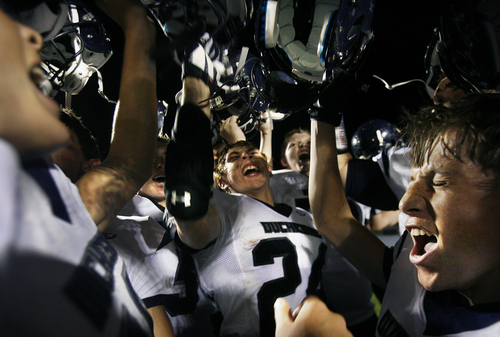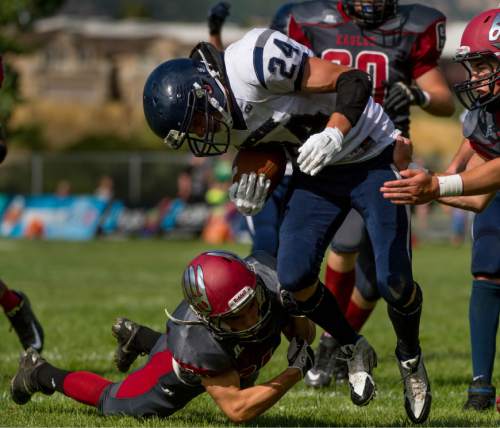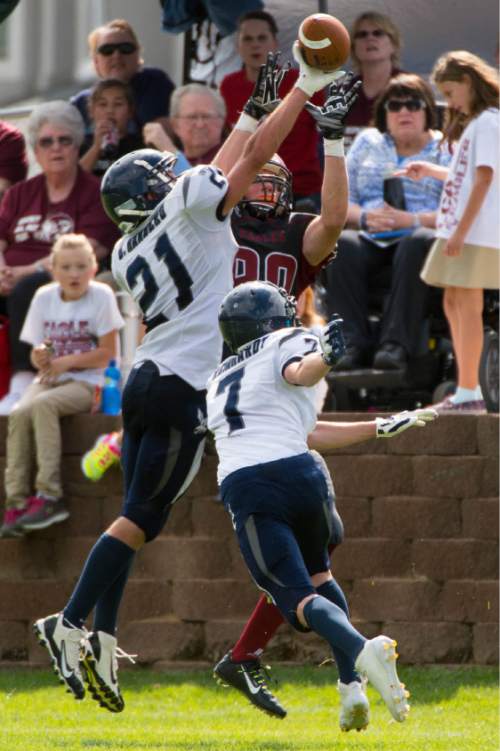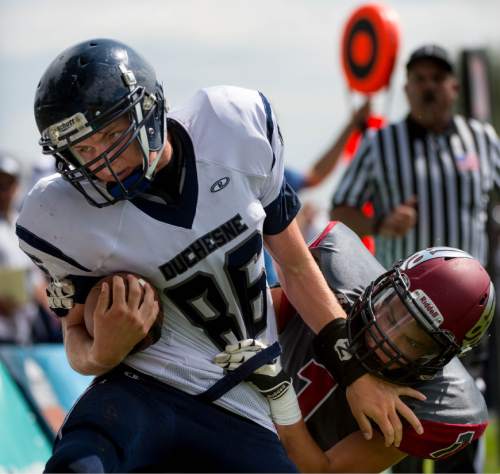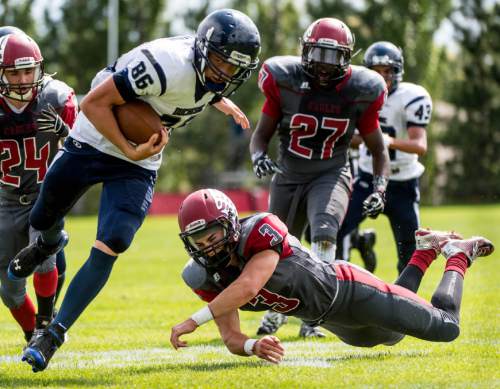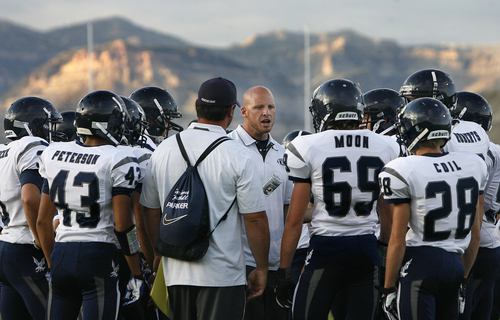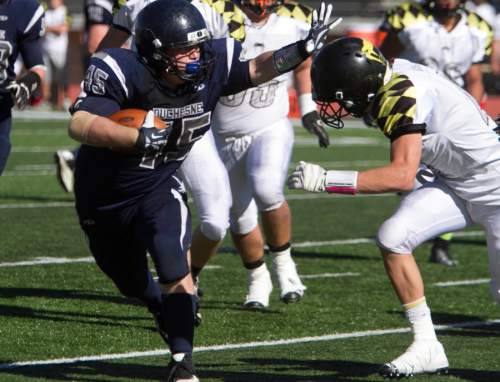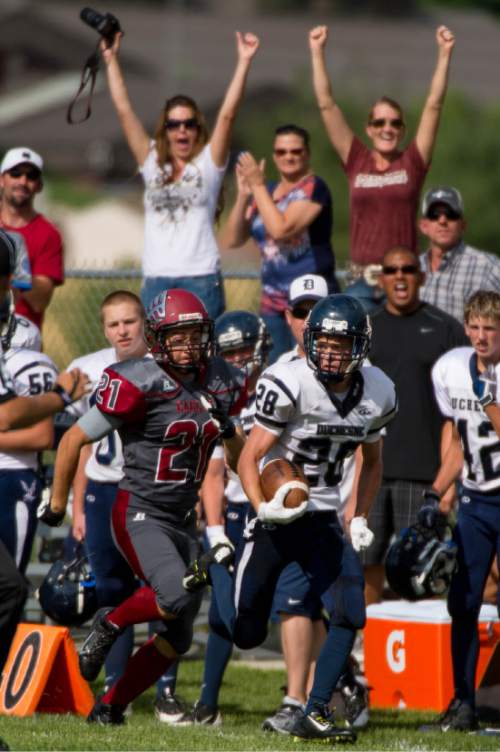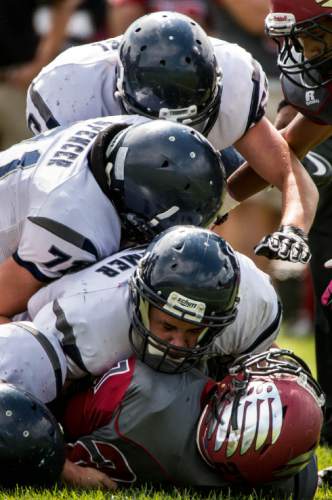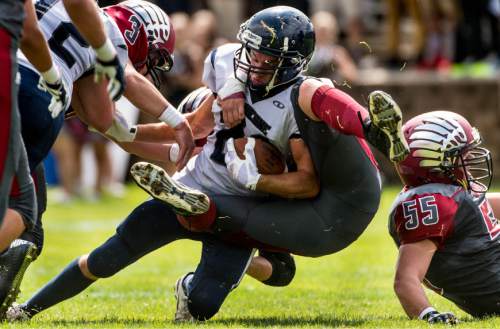This is an archived article that was published on sltrib.com in 2014, and information in the article may be outdated. It is provided only for personal research purposes and may not be reprinted.
For the Duchesne Eagles, the long bus rides back to the basin when the nearest road game is a two-hour drive away have at least been more palatable in recent years on account of four straight state titles and a state-record 48-game winning streak (which was snapped Friday by North Summit, the No. 1-ranked team in Class 2A).
Along the Arizona border, the views at Monument Valley High School are spectacular, though assembling a team is never easy.
And tucked up in the northeast corner of the state, the idea of "Friday night lights" doesn't exist at Rich High in Randolph. Football has always been played in the late afternoon because there are no lights at the stadium. Furthermore, any time the possibility of changing that comes up, it's quickly shot down; by midseason, it would simply be too cold to watch a game after the sun had set.
These are only some of the challenges and charms of playing football in Utah's smallest classification. For the state's smallest schools, they are points of pride. And that's why they push for more to join them.
As the Utah High School Activities Association considers its realignment for the 2015 and 2016 seasons, administrators would like to see a reversal of course from the last realignment, when Class 1A was cut down to nine teams.
"What we see is, if that trend continues, then we see an issue with 1A football being a viable program," Duchesne High principal Stan Young says.
Small-town football in Utah has been through tough times before. The move to a five-classification system in 1993 left 1A with 33 schools, but only seven that played football. And from 1997-2000, the class completely dissolved, forcing both Rich and Duchesne to move up to Class 2A.
The state's smallest class was resurrected in 2001 and has limped along since, taking its most recent hit last year when the state went to six classes for football.
Even if it meant adding a 10-hour round trip to the Eagles' schedule, Duchesne was glad to see the Kanab Cowboys drop down to 1A last fall, meaning nine teams could compete for the 1A state title.
Officials don't want to see it stop there, however, and most are in favor of adding North Sevier, Parowan and some other small 2A schools to the mix.
But UHSAA president Rob Cuff says there is some concern about enrollment disparity between the smallest 1A schools and schools that could potentially move down. Parowan's roughly 350 students may not be many — until you compare them to Monument Valley's 225.
Adding new blood to 1A is a difficult balance. In most cases, cost and small enrollment numbers make fall baseball a more attractive alternative.
Hoping to entice more schools to join, UHSAA and others have offered another suggestion at various points over the years.
"We've always talked about six-, eight- or nine-man football," Cuff said. "But none of those [existing football] schools really want to do that."
For Duchesne, Rich and the others, it would be a step away from tradition.
"We would oppose that adamantly," Young said.
It's a standstill that has made it difficult for other schools to take up football. "It's really hard to get excitement going for more schools to have football, because they have to come on with 11-man teams," Cuff said.
Nevertheless, some will try.
This year, funded almost entirely by community donations (from the helmets to the uprights), Wayne High School is playing a nine-game junior varsity schedule.
"The field's hard as heck," Wayne athletic director Heidi Woolsey said. "It's got night crawlers in it and stuff, and it doesn't hold water too well. But the coach lines it and they just go out and play."
Last weekend, on a brisk afternoon, about 150 people turned out to watch the 24 boys who make up Wayne's first-ever football team force overtime against Milford.
That's the kind of support that shows up in small towns, said Rich superintendent Dale Lamborn.
"What football does for our community, in terms of bring us together and keeping the kids focused, is huge," he said. "We're stuck up here surrounded by Idaho and Wyoming. But I believe strongly our kids ought to have the same opportunities."
Said Duchesne running back Dylan Despain, "Football means everything. Football's been my life since I was in the fourth grade. All my brothers played it. I just love football."
Over recent years, Rich and Duchesne have started to form one of the state's best rivalries, facing of in four of the last five 1A title games. Last fall, Duchesne came out the winner, stopping Rich on a two-point conversion that could have won the game.
"Winning a state championship is fun and exciting no matter who, how or when it happens," said Young. "Having said that, I've heard discussions even here that, to make it a real illustrious thing, it would be better if we had some of those other schools.
"There are great programs. There just aren't enough of us."
Kevin Winters Morriss contributed to this story.
Twitter: @aaronfalk —
Small ball
Class 1A football currently fields only nine programs:
• Altamont
• Diamond Ranch (Hurricane)
• Duchesne
• Kanab
• Milford
• Monticello
• Monument Valley
• Rich (Randolph)
• Whitehorse (Montezuma Creek) —
Recent timeline of Class 1A
1993 • State's move to a five-classification system leaves 1A with 33 programs, only seven of which play football
1997 • Class 1A football is completely dissolved
2001 • 1A football is re-implemented after four-year hiatus
2013 • State's move to six classifications leaves only nine football-playing teams in 1A —
Potential solutions
Realignment • The UHSAA realigns its programs every two years, and has discussed dropping several programs from Class 2A down to 1A, including North Sevier and Parowan.
Expansion • Thanks to community funding, Wayne High School (which competes in 1A in other sports) implemented a football program for the first time in its history this year and is playing a nine-game JV schedule.
Smaller teams • As a means of generating further expansion among low-enrollment schools, UHSAA has suggested that 1A teams switch from traditional 11-on-11 games to 6-on-6, 8-on-8 or 9-on-9. Existing 1A programs have opposed the idea, however.




